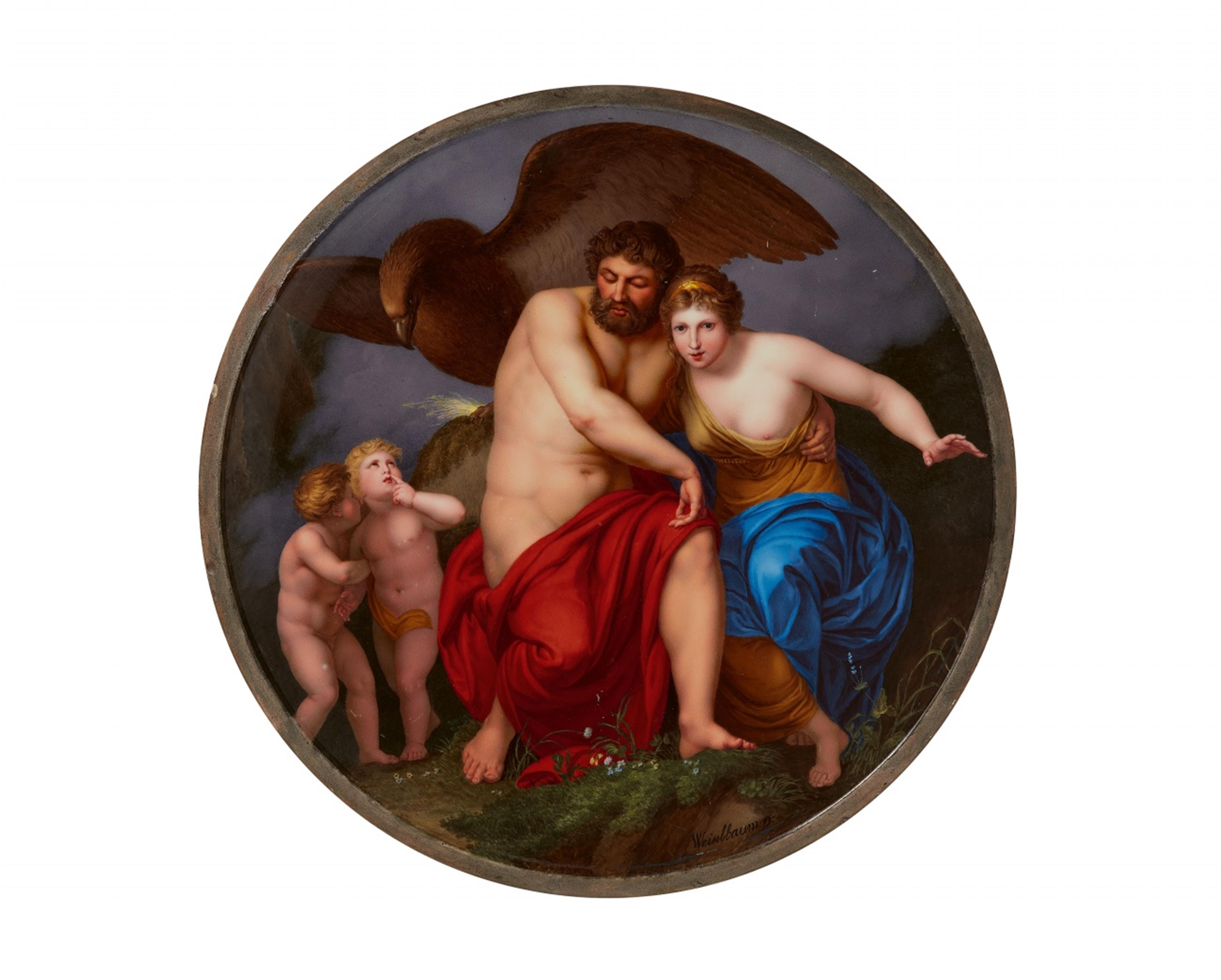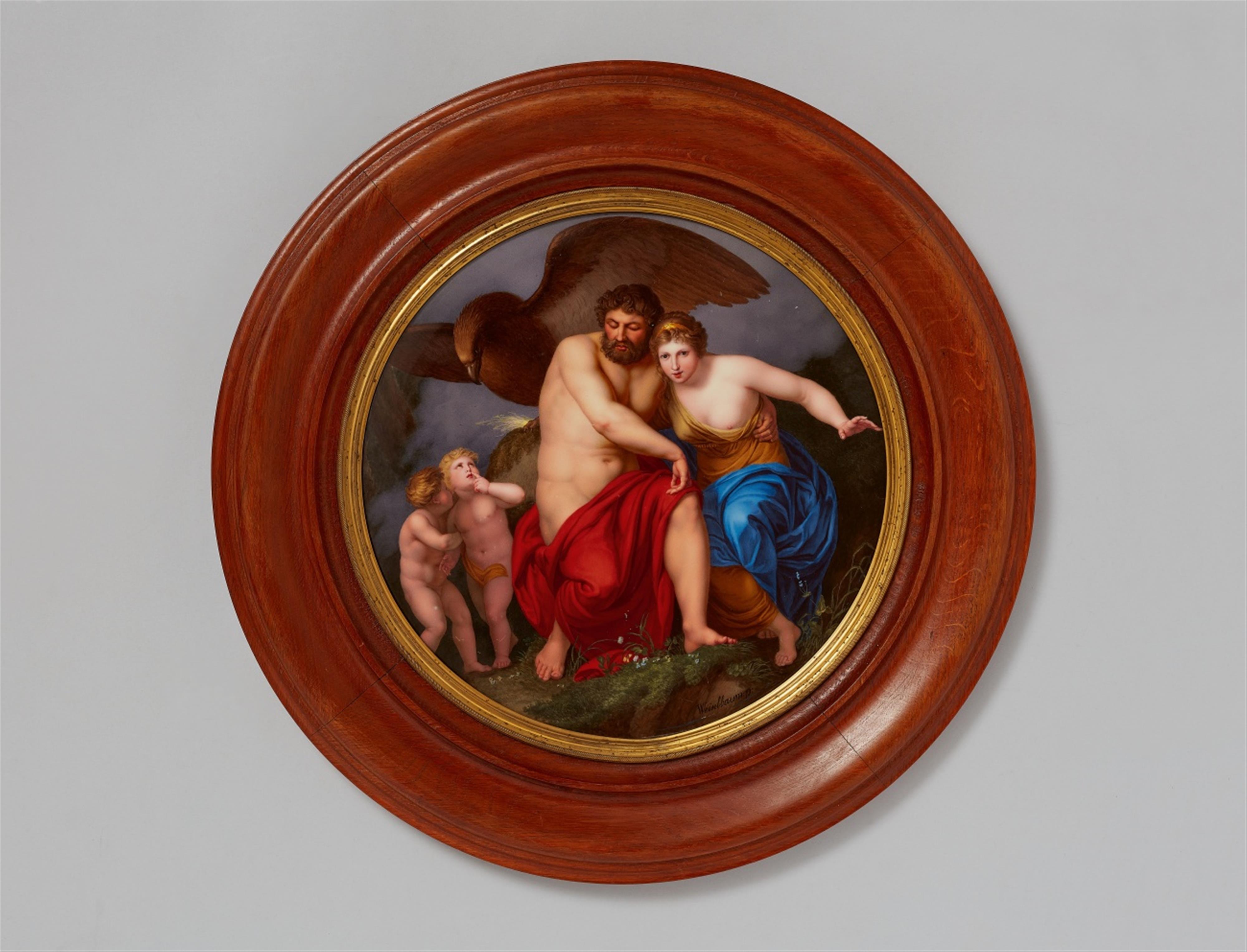An important Vienna porcelain plaque depicting "Hera putting Zeus to Sleep on Mount Ida"
Signed in the lower half "Weixelbaum pinx." With an indistinct blue bindenschild mark on the unglazed reverse, year stamp 808, dreher's number 6 for Peter Scherer. D 33, in a modern wooden surround D 47.8 cm.
Imperial Porcelain Manufactory under Konrad von Sorgenthal, 1808, painted by Johann Weichselbaum.
This exceptionally finely painted plaque presents a reproduction of a work by Andries Cornelis Lens (1739 - 1822) that was painted in 1775 for M. de la Ferté in Paris. The piece is known to have been housed in the Museum of Fine Arts in Vienna since 1783 (inv. no. 1367) and Karl Hermann Pfeiffer made an engraving of the work in 1803.
Johann Weichselbaum (1752 - 1840) visited the Vienna Academy and was a pupil of Heinrich Friedrich Füger. He entered the porcelain manufactory as a design and figure painter in 1772, becoming a chief painter in 1784 and chief painter of the history painting department in 1797.
Fine Nuances
Claudia Lehner-Jobst
A working colour palette is among the most essential tools needed by any artist. After all, a generous selection of colours to mix is akin to a kiss from a muse. In porcelain painting especially, there are a great many technical and material hurdles to be overcome before this kiss can blossom into art. Enamel colours need to be able to withstand the high temperatures of the firing process to develop their final tones and shine. During firing they become inseparably bonded to the glaze, allowing their splendour to remain conserved forever in a lightfast manner.
Since the founding of the imperial Vienna porcelain manufactory in the year 1718, the important task of developing suitable enamel colours from mineral oxides had been among the most vital duties performed by the arcanists, the experts and guardians of the manufactory's secret formulas. As early as November 1719, the envoy of Saxony in Vienna, Christian Anacker, was already reporting to the inspector of the Meissen manufactory Johann Melchior Steinbrück about the progress which he observed with suspicion within the private company located outside the gates of the imperial residential city. The first porcelain paintings in underglaze blue created by its founder Claudius Innocentius du Paquier were said to have achieved a delicacy previously only known in East Asian productions. The manufactory had already perfected the mixtures for the primary colours by 1725 at the latest. Meissen were very interested in their new competition. One manufactory worker, Samuel Stötzel, was sent to Austria from Saxony as a "deserter" in 1718 to learn the secrets of Vienna. His clandestine return in 1720 was impatiently awaited, "... since previously in Saxony, they did not know what blue, green, and red etc. on porcelain was."
The manufactory in Vienna was able to expand its spectrum at an astonishing speed. Their floral décor, monochrome landscapes, colourful genre scenes, and subtly painted figures gained ever finer nuances during the reign of Empress Maria Theresia (see lots 1, 4, 5, 9, 49 - 52). During this time, a fashion developed for services and déjeuners in bold colours inspired by the service with the green ribbon which the Empress had presented as a diplomatic gift to Louis XV in 1758 in celebration of their new alliance. Another interesting development during this time was the introduction of décor in the style of the fashionable chiné fabrics which had been used in women's garments since the mid-18th century (lots 2 and 3).
Another of the Vienna manufactory's strengths was the famous "lustre" of their colours, which was perfected under the direction of the economist Conrad von Sorgenthal (1733-1805), who was assigned to the manufactory by Emperor Joseph in 1784. Sorgenthal introduced a painting school to the manufactory and ensured that his artists received an academic education. In the spirit of the Enlightenment, Konrad Sorgenthal encouraged the development of the "genius" by furnishing the manufactory with historical and philosophical literature as well as the latest engravings and illustrated publications for use as prototypes. Reason and sentiment should both play a role in artistic endeavour, and should be combined to invoke the manufactory's products with edifying qualities.
Johann Weichselbaum was among the most accomplished painters at the Vienna manufactory. He became head painter of its most esteemed department, that of history and landscape painting, in 1797. He had studied at the Vienna Academy under Heinrich Friedrich Füger and was thus acquainted with some of the foremost protagonists of Classicism. The reproduction of a work showing Zeus and Hera (lot 46) that bears his signature attests to the artist's exceptional mastery of the challenges of porcelain painting. In Weichselbaum's copy, the rectangular format of the original painting has been converted into a tondo, following the curve of the eagle's wings and the arm of the goddess Hera. Sources indicate that the artist reiterated this subject in several versions. On 5th August 1804, Weichselbaum is known to have received a prize from the manufactory for a depiction of "Jupiter and Juno" which was awarded by Baroness Zichy in the presence of three archdukes. The manufactory's log books also mention his payment for the completion of several plates with depictions of "Jupiter and Juno on Ida" after the painter "Lenz", namely 45 gulders in February 1805, 45 gulders in November 1806, and a pre-payment of 10 gulders in January 1807. Records starting in April 1808 list a payment of 1,400 gulders for the painting of a large platter, although they fail to mention the subject.
The realisation that "without good colouring, even the most artfully painted piece makes a bad impression" inspired Sorgenthal to send his artists to the imperial art galleries, those of the princes of Liechtenstein and those of the counts of Fries and Lamberg-Sprinzenstein to gather experience through copying the works of new and older masters. These copies, or reductions, painted in oils and watercolours and reproduced in miniature on porcelain panels and services formed a new artistic genre: "the fact that paintings on porcelain should be more expensive than other paintings is evident."
Sorgenthal provided the flower painter and talented scientist Joseph Leithner with university education, a library of specialist literature, and a laboratory: "It is thanks to him that the factory boasts such a rich variety of colours", he was rewarded with prizes and remunerated handsomely. Leithner developed a bronze glaze in 1791 and in 1792 he created a perfectly even ground in deep cobalt blue that went down in the history of the Vienna manufactory as "Leithner's blue" (lot 16) and which allowed Vienna to imitate the décor used at Sèvres. In the same year he perfected copper lustre ground (examples in lots 10 - 14), and in 1793 the gold mixture for precious gold relief ornaments. After 1800, Leithner developed pure black, orange, and chromium green pigments that perfectly suited the tastes of the Empire style. This was followed by a platinum glaze in 1805. The painter Franz Osterspey changed from the Vienna manufactory to Berlin KPM in 1797, where his works were praised for their bold style and exceptional lustre. According to Osterspey, the secret of the Vienna porcelain colours lay in the quality of their pigments, which could be layered on top of one another without blurring "this provided the perfect conditions for the creation of fine nuances in painting."
The daring colour combinations and endless varieties of ornament found in Viennese Classicism were developed thanks to the creative atmosphere propagated under Conrad von Sorgenthal. Competitions and exhibitions spurred the various workshops on in the creation of countless new motifs. The surprising number of designs for cups and saucers catered to a new fashion at the time: "Customers buy only single examples of the finest cups in order to bring the greatest variety to their tea and coffee tables." At that time, the manufactory was able to draw from a palette of 36 main colours, the majority of which could be mixed with one another. A set of colour samples recently sold by Lempertz Cologne (auction 1140, 15th November 2019, lot 846) is now housed in the porcelain museum in Augarten, Vienna. The chemist, physician, and then director of the manufactory Benjamin von Scholz wrote in 1819, "With regard to both the beauty and variety of colour and the artistic value of the paintings produced here, you do not have to compete with any other factory."




